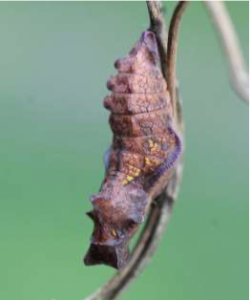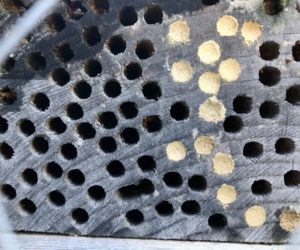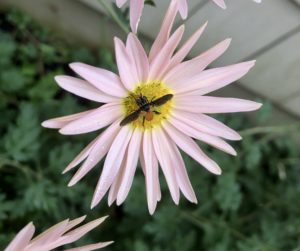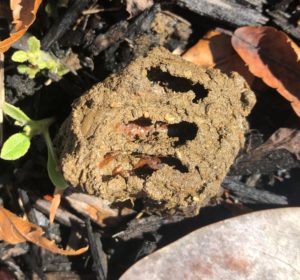While we are thinking of ways to thank nature for the bounty provided to us over the course of the year, understanding where and how our pollinators spend the winter months allows us to give them a helping hand to ensure their survival until springtime. Our winter gardens, mulched areas, soil and messy corners provide a safe haven for them. Many of these essential creatures have the ability to withstand the cold winter temperatures and howling winds, peacefully resting in snow covered areas right under our feet.
 Most insects undergo diapause as winter approaches. This is a term that describes a period of suspended development in an insect. It is characterized by cessation of growth and a reduction of metabolic activity. It most often occurs seasonally or when environmental conditions are unfavorable. Insects are affected by the shorter day length, cooling autumn temperatures and a decrease in food sources. This results in hormonal changes leading to diapause. In some insects, chemicals are released that prevent the insect from freezing; a ‘natural antifreeze’ if you will.
Most insects undergo diapause as winter approaches. This is a term that describes a period of suspended development in an insect. It is characterized by cessation of growth and a reduction of metabolic activity. It most often occurs seasonally or when environmental conditions are unfavorable. Insects are affected by the shorter day length, cooling autumn temperatures and a decrease in food sources. This results in hormonal changes leading to diapause. In some insects, chemicals are released that prevent the insect from freezing; a ‘natural antifreeze’ if you will.
Let’s take a look at a few of our common pollinators, starting with the butterflies and moths we enjoy every summer. It depends on the species, but most commonly they ride out winter in the caterpillar stage. Our fritillary and hairstreak caterpillars burrow in leaf litter at the base of their host plant. The caterpillars awaken when the weather warms, which coincides with the regrowth of their host plant, providing them with food. The last generation of monarch butterflies migrate as adults, returning north in the spring. Swallowtails spend the winter above ground in their chrysalis, camouflaged against the brown stems and leaves. Most moths are cozy in their cocoons, either above ground or underground.
Everyone knows how important the European honey bees are for pollinating our food supply. Once they are unable to forage in the fall, the honey bees need to rely on stored honey to get them through the winter. As the temperatures drop, the worker bees cluster around their queen and the stored honey. Bees near the center keep warm and are able to eat. As the bees on the outer edges of the cluster get chilled or hungry, they move towards the center to take their turn getting food and warmth. As the temperature drops, the bees begin to shiver their muscles, which raises their body temperature and the hive begins to warm.
At Tyler, our beekeepers keep an eye on the food supply within our hives, supplementing the hive with honey if necessary. In the wild, if the honey is exhausted, the entire colony can starve to death.
There are about 4,000 native bee species in North America, and about 75% of these are solitary bees. They are on their own to gather food, build nests and lay eggs. No doting workers care for the solitary bees. Their adult lifespan is rather short, usually 2-4 weeks, and it’s spent gathering nectar and pollen, with the females preparing a nest for the next generation. Their nests are usually below ground, but some nest above ground in hollow stems, crevices or even man-made structures such as this bee home found at Tyler. Depending on the species, either the adult bee or larva will survive winter in the nest until the weather warms.

Flies and beetles look for crevices if they overwinter as adults, but most will spend the winter 1-6 inches underground in their pupa stage, in a state of diapause. The grubs you find in your yard are beetle larva, some are beneficial pollinators, and some are not. While beetles and flies may not be the most welcome pollinators, they definitely do a lot of the work. With over 300,000 types of beetles and 120,000 types of flies, there’s plenty to observe each year. The swift feather-legged fly seen here consuming nectar is an example of one you might find, perhaps one you haven’t seen previously.
The last pollinator we will take a look at is the wasp. Other than the mated queen, wasps don’t survive the winter, dying off due to either a lack of food or the cold weather. The queen will look for a crevice under bark, within rocks, or in a burrow, waiting for the spring warmth. You could even find them in garden debris, or less ideally, inside your home. If you do find a dead wasp in your home in the winter, it is likely a queen, awakened too soon by the warmth, and dying from starvation.
While there are certain differences in how our pollinators spend the winter, the common theme is to allow leaf litter, clipped stems and spent annuals to remain until spring, providing the environment the slumbering pollinators need to survive the winter. We work hard to support them in the spring and summer, so let’s keep helping them through the fall and winter by letting them spend the winter with us too. It’s a difficult time of year for these essential insects, and the stakes are high, both for their populations and for our communities. One in three bites of food we take is thanks to a pollinator, and this is a perfect opportunity to thank them!
 Let’s rake our leaves into the back corner of our property, rather than bagging them at the curb. Sticks, rotting logs, and loose soil are also an ideal environment. This insect home was found in a lightly mulched garden. While we don’t know what insects used this or when, we can see brown fragments of the insect’s protective covering inside two of the openings. The home looks quite fragile, but allows us to see how loose soil makes a great home for insects. By changing a few simple gardening steps, more of our pollinators will return in the spring to delight us for another year.
Let’s rake our leaves into the back corner of our property, rather than bagging them at the curb. Sticks, rotting logs, and loose soil are also an ideal environment. This insect home was found in a lightly mulched garden. While we don’t know what insects used this or when, we can see brown fragments of the insect’s protective covering inside two of the openings. The home looks quite fragile, but allows us to see how loose soil makes a great home for insects. By changing a few simple gardening steps, more of our pollinators will return in the spring to delight us for another year.






